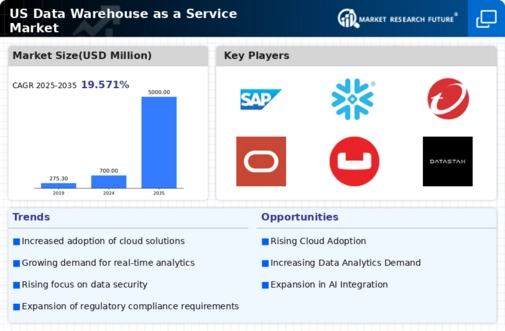Increased Focus on Data Governance
Data governance has emerged as a pivotal concern for organizations utilizing data warehouse-as-a-service solutions. With the growing volume of data being generated, companies are prioritizing the establishment of robust governance frameworks to ensure data quality, security, and compliance. This focus is particularly relevant in regulated industries such as healthcare and finance, where adherence to strict data regulations is paramount. The data warehouse-as-a-service market is responding to this need by offering enhanced governance features, which are expected to drive market growth. As organizations strive to maintain data integrity and compliance, the emphasis on effective data governance will likely continue to shape the landscape of the data warehouse-as-a-service market.
Growing Demand for Scalable Solutions
The data warehouse-as-a-service market is experiencing a notable surge in demand for scalable solutions. Organizations are increasingly seeking flexible data storage options that can grow alongside their business needs. This trend is particularly pronounced in sectors such as retail and finance, where data volumes are expanding rapidly. According to recent estimates, the market is projected to reach approximately $10 billion by 2026, reflecting a compound annual growth rate (CAGR) of around 25%. This growth is driven by the need for businesses to manage large datasets efficiently while minimizing infrastructure costs. As companies continue to embrace digital transformation, the demand for scalable data warehouse solutions is likely to intensify, further propelling the data warehouse-as-a-service market forward.
Emergence of Real-Time Data Processing
The rise of real-time data processing capabilities is transforming the data warehouse-as-a-service market. Organizations are increasingly demanding solutions that allow for immediate data analysis and reporting, enabling them to make timely decisions. This trend is particularly relevant in industries such as e-commerce and telecommunications, where real-time insights can drive competitive advantage. The market for real-time data processing is expected to grow at a CAGR of over 20% in the coming years, indicating a strong shift towards immediate data accessibility. As businesses seek to harness the power of real-time analytics, the data warehouse-as-a-service market is likely to benefit from this growing demand.
Shift Towards Cost-Effective Data Management
Cost efficiency remains a critical driver in the data warehouse-as-a-service market. Organizations are increasingly recognizing the financial benefits of adopting cloud-based data solutions over traditional on-premises systems. By leveraging data warehouse-as-a-service, companies can significantly reduce capital expenditures associated with hardware and maintenance. Reports indicate that businesses can save up to 30% on operational costs by migrating to cloud-based data solutions. This shift not only allows for better allocation of resources but also enables organizations to invest in advanced analytics and business intelligence initiatives. As the focus on cost-effective data management continues to grow, the data warehouse-as-a-service market is poised for sustained expansion.
Integration of Artificial Intelligence and Machine Learning
The integration of artificial intelligence (AI) and machine learning (ML) technologies is significantly influencing the data warehouse-as-a-service market. Organizations are increasingly leveraging these advanced technologies to enhance data analysis and predictive capabilities. By incorporating AI and ML into their data warehouse solutions, businesses can automate data processing, uncover hidden patterns, and generate actionable insights. This trend is expected to propel the market forward, with projections indicating that AI-driven data solutions could account for over 40% of the data warehouse-as-a-service market by 2027. As companies continue to explore the potential of AI and ML, the demand for innovative data warehouse solutions is likely to grow.
























Leave a Comment